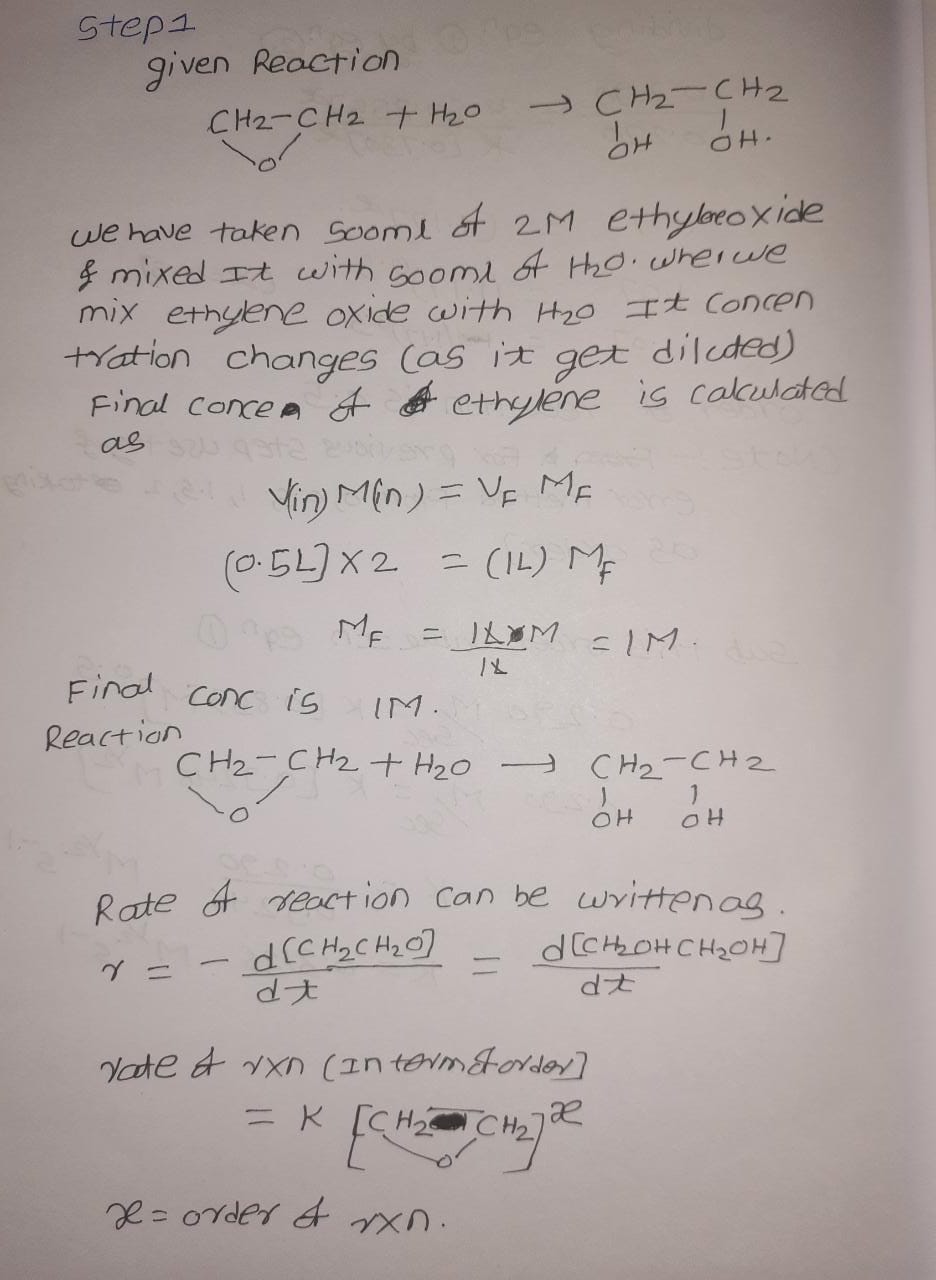Additional Problem #3: The hydrolysis of ethylene oxide in the presence of H2SO4 catalyst to CH2CH20 + H2O → CH2OHCH2OH ethylene glycol: has been studied at 55°C by mixing 500 ml of a 2M solution of ethylene oxide in H2O with 500 ml of H20 containing 0.9 wt. % H2SO4. Note that H2SO4 is a catalyst and is NOT consumed during the reaction. Use the data below to determine the reaction order and the value of the rate constant. The reactor can be modeled as a batch reactor. (Note that the reaction was conducted in excess H20 and its concentration did not change.) Time (min) Concentration of Ethylene Glycol (mol/L) 0.000 0.0 0.145 0.5 0.270 1.0 0.376 1.5 0.467 2.0 0.610 3.0 0.715 4.0 0.848 6.0 0.957 10.0
Additional Problem #3: The hydrolysis of ethylene oxide in the presence of H2SO4 catalyst to CH2CH20 + H2O → CH2OHCH2OH ethylene glycol: has been studied at 55°C by mixing 500 ml of a 2M solution of ethylene oxide in H2O with 500 ml of H20 containing 0.9 wt. % H2SO4. Note that H2SO4 is a catalyst and is NOT consumed during the reaction. Use the data below to determine the reaction order and the value of the rate constant. The reactor can be modeled as a batch reactor. (Note that the reaction was conducted in excess H20 and its concentration did not change.) Time (min) Concentration of Ethylene Glycol (mol/L) 0.000 0.0 0.145 0.5 0.270 1.0 0.376 1.5 0.467 2.0 0.610 3.0 0.715 4.0 0.848 6.0 0.957 10.0
Chemistry
10th Edition
ISBN:9781305957404
Author:Steven S. Zumdahl, Susan A. Zumdahl, Donald J. DeCoste
Publisher:Steven S. Zumdahl, Susan A. Zumdahl, Donald J. DeCoste
Chapter1: Chemical Foundations
Section: Chapter Questions
Problem 1RQ: Define and explain the differences between the following terms. a. law and theory b. theory and...
Related questions
Question

Transcribed Image Text:- + 100%
7 of 8
Additional Problem #3: The hydrolysis of ethylene oxide in the presence of H2SO4 catalyst to
CH2CH2O + H20 → CH2OHCH2OH
ethylene glycol:
has been studied at 55°C by mixing 500 ml of a 2M solution of ethylene oxide in H20 with 500
ml of H20 containing 0.9 wt. % H2SO4. Note that H2SO4 is a catalyst and is NOT consumed
during the reaction. Use the data below to determine the reaction order and the value of the
rate constant. The reactor can be modeled as a batch reactor. (Note that the reaction was
conducted in excess H2O and its concentration did not change.)
Time (min)
Concentration of Ethylene Glycol (mol/L)
0.000
0.0
0.145
0.5
0.270
1.0
0.376
1.5
0.467
2.0
0.610
3.0
0.715
4.0
0.848
6.0
0.957
10.0
Additional Problem #4: A convenient laboratory technique for determining the kinetics of gas
phase reactions involves using a constant volume isothermal vessel and measuring pressure
changes with time. The container can be modeled as a batch reactor. Use the data below to
Expert Solution
Step 1

Trending now
This is a popular solution!
Step by step
Solved in 3 steps with 3 images

Knowledge Booster
Learn more about
Need a deep-dive on the concept behind this application? Look no further. Learn more about this topic, chemistry and related others by exploring similar questions and additional content below.Recommended textbooks for you

Chemistry
Chemistry
ISBN:
9781305957404
Author:
Steven S. Zumdahl, Susan A. Zumdahl, Donald J. DeCoste
Publisher:
Cengage Learning

Chemistry
Chemistry
ISBN:
9781259911156
Author:
Raymond Chang Dr., Jason Overby Professor
Publisher:
McGraw-Hill Education

Principles of Instrumental Analysis
Chemistry
ISBN:
9781305577213
Author:
Douglas A. Skoog, F. James Holler, Stanley R. Crouch
Publisher:
Cengage Learning

Chemistry
Chemistry
ISBN:
9781305957404
Author:
Steven S. Zumdahl, Susan A. Zumdahl, Donald J. DeCoste
Publisher:
Cengage Learning

Chemistry
Chemistry
ISBN:
9781259911156
Author:
Raymond Chang Dr., Jason Overby Professor
Publisher:
McGraw-Hill Education

Principles of Instrumental Analysis
Chemistry
ISBN:
9781305577213
Author:
Douglas A. Skoog, F. James Holler, Stanley R. Crouch
Publisher:
Cengage Learning

Organic Chemistry
Chemistry
ISBN:
9780078021558
Author:
Janice Gorzynski Smith Dr.
Publisher:
McGraw-Hill Education

Chemistry: Principles and Reactions
Chemistry
ISBN:
9781305079373
Author:
William L. Masterton, Cecile N. Hurley
Publisher:
Cengage Learning

Elementary Principles of Chemical Processes, Bind…
Chemistry
ISBN:
9781118431221
Author:
Richard M. Felder, Ronald W. Rousseau, Lisa G. Bullard
Publisher:
WILEY